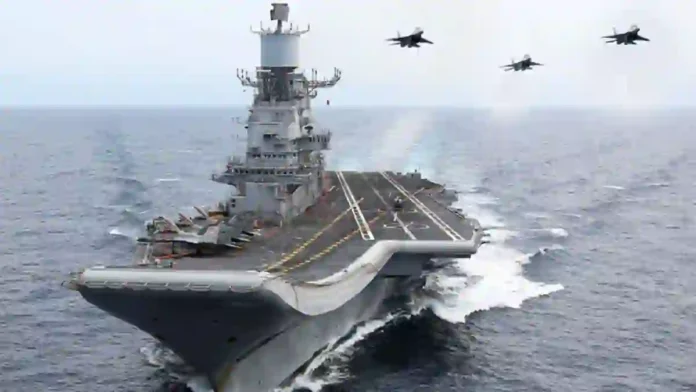by Sankalp Gurjar sundayguardianlive
Three latest developments indicate the growing interest of major global powers in the Indian Ocean geopolitics, despite the crises in Europe and West Asia. First, India hosted the 2+2 dialogue with the foreign and defence ministers of the United States in Delhi in which several dimensions of the Indian Ocean rim figured in the discussions. Second, the Chinese navy exercised with the Pakistani navy in the Arabian Sea.
Finally, Russian naval warships exercised with the Burmese navy and paid a visit to the port of Chattogram in Bangladesh. Of the three developments, two are indicative of broader strategic trends that have already been set in motion: deepening of Indo-US ties and reinforcing the China- Pakistan quasi-alliance. Russia’s growing interest in Indian Ocean geopolitics is a new development. However, taken together, these developments indicate the growing interest of major global powers in the Indian Ocean.
India-US 2+2: Maritime Dimensions
India-US 2+2 dialogue has emerged as the premier forum for top officials from India and the US to discuss possible areas of cooperation and manage the diverging viewpoints about global affairs. As per the joint statement issued after the dialogue, India and the US agreed to collaborate to share maritime technologies and also co-operate for managing the undersea domain. In the last few years, Indian shipyards are emerging as trusted partners for the US navy to maintain, repair and overhaul their ships, specifically the aircraft carriers.
Augmenting this collaboration and attracting the US investments in this sector is also on the cards. It will help in building Indian capabilities, further familiarize India and the US navies with each other including in the domain of technologies as well as deepen the interoperability between the two navies. This will be a key development for the Indian Ocean geopolitics.
Moreover, India has joined the US-led maritime security initiative known as Combined Maritime Force (CMF) which is based in Bahrain. Under the aegis of CMF, there are four task forces that undertake maritime security related functions, primarily in the Persian Gulf, Western Indian Ocean and in the Red Sea region. The Indo-US collaborative effort of the India-Middle East-Europe corridor (IMEC) will also be a gamechanger in the geopolitics of the northern Indian Ocean rim and will re-orient the trade and investment flows. Given the US’ steadily growing interest in the Indian Ocean and India’s expanding maritime engagements, Indo-US partnership in the Indian Ocean will attain increasing strategic importance.
China-Pakistan Naval Exercises
The naval drills between China and Pakistan are an annual affair. However, this time the exercises were the largest ever. These naval drills are as much about naval cooperation as they are about political signalling. Both countries seek to balance India’s growing power in the Indian Ocean. In the last 15 years, China has sought to expand its naval presence in the Indian Ocean whereas for Pakistan, China is a key partner in military modernization.
China-Pakistan Economic Corridor (CPEC) is a seemingly signature project in the Belt and Road Initiative and as per the Chinese officials, the naval exercises were aimed at safeguarding the CPEC. The drills obviously indicate the growing naval dimension of China- Pakistan strategic partnership. For the exercises, China had sent an advanced destroyer and a submarine.
Apart from the exercises with South African, Iranian, and Russian navies in the Indian Ocean, China-Pakistan maritime security drills contribute to the strengthening of Chinese naval presence in the region. As China seeks to establish more military bases in the Indian Ocean, including in the Persian Gulf and Gulf of Oman, such exercises familiarize the Chinese navy with the Indian Ocean and regularize their presence in Indian Ocean waters.
There are reports of Chinese interest in acquiring a military base in Oman which will support and complement the military base in Djibouti. For India and the Indian Ocean, the naval dimensions of China-Pakistan quasi-alliance is a serious challenge.
Read- ZORAWAR LIGHT TANK SET TO STRENGTHEN BORDER DEFENCE
Russia In Bay of Bengal
In addition to the US and China, Russia is also taking steady steps to expand its presence in the Indian Ocean. So far, it has been more focused on the Western Indian Ocean. However, it is gradually expanding its presence in the Eastern Indian Ocean. Russia’s naval exercises with Myanmar and port visit to Bangladesh have to be seen in this context.
Russia is a close strategic partner of Myanmar and is deepening strategic cooperation with Bangladesh. The expanding Russian presence in the Indian Ocean raises questions about the nature of activities and collaborations. Will Moscow, working in tandem with Beijing, be more aggressive in the Indian Ocean like it has been in the Western Pacific? How do regional powers look at the Russian naval expansion? What is the role of, and implications for, India in the evolving geopolitics? Although it is too soon to consider Russian presence as a development that will shape regional geopolitics, Moscow’s growing presence and interest cannot be overlooked.
To be sure, the Indian Ocean has been attaining centre-stage in global geopolitics in the last two decades. However, developments in other parts of the world such as the war in Ukraine, Israel-Palestine crisis tend to push the Indian Ocean to the periphery. For India, what happens in the Indian Ocean matters directly for its national security and foreign policy interests. In this context, the growing presence and strategic interest of China and Russia in the Indian Ocean region needs to be watched carefully.




